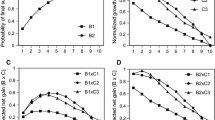Abstract
Dolman (1995) measured the intake rates of snow buntings feeding on seed patches at difference bird densities, for each of two different seed densities. Interference occurred in the low food density treatment, with intake rate declining at high bird densities, but did not occur in the high food density treatment. Dolman states that existing models of the interference process assume that the intensity of interference is independent of food density. While this statement is true for the model of Hassell and Varley (1969), we show that behaviour-based models of interference do not assume that interference is independent of food density. We examine two simple analytic behaviour-based models of interference and show that, in agreement with Dolman's observations, intensity of interference is predicted to decrease with increasing food density. Dolman plotted log (intake rate) against log (bird density). Rather than obtaining a linear relationship predicted by the Hassell and Varley model, the results from the low seed density treatment indicated a curvilinear relationship consistent with those produced by our behaviour-based models. These results provide support for the use of behaviour-based models of interference over the model of Hassell and Varley.
Similar content being viewed by others
References
Beddington JR (1975) Mutual interference between parasites or predators and its effect on searching efficiency. J Anim Ecol 44: 331–340
Bernstein C, Kacelnik AJ, Krebs JR (1988) Individual decisions and the distribution of predators in a patchy environment. J Anim Ecol 57: 1007–1026
Bernstein C, Kacelnik AJ, Krebs JR (1991) Individual decisions and the distribution of predators in a patchy environment. II. The influence of travel costs and structure of the environment. J Anim Ecol 60: 205–225
Dolman PM (1995) The intensity of interference varies with resource density: evidence from a field study with snow buntings, Plectrophenox nivalis. Oecologia 102: 511–514
Elgar MA (1989) Predator vigilance and group size in mammals and birds: a critical review of the empirical evidence. Biol Rev 64: 13–33
Ens BJ, Goss-Custard JD (1984) Interference among oystercatchers, Haematopus ostralegus, feeding on mussels, Mytilus edulis, on the Exe estuary. J Anim Ecol 53: 217–231
Free CA, Beddington JR, Lawton JH (1977) On the inadequacy of simple models of mutual interference for parasitism and predation. J Anim Ecol 46: 543–554
Goss-Custard JD, Caldow RWG, Clarke RT, Durell SEA le V dit, Sutherland WJ (1995) Deriving population parameters from individual variations in foraging behaviour. I. Empirical game theory distribution model of oystercatchers Haematopus ostralegus feeding on mussels Mytilus edulis. J Anim Ecol 64: 265–276
Hassell MP (1971) Mutual interference between searching insect parasites. J Anim Ecol 40: 473–486
Hassell MP, May RM (1973) Stability in insect host-parasite models. J Anim Ecol 42: 693–726
Hassell MP, Rogers DJ (1972) Insect parasite responses in the development of population models. J Anim Ecol 41: 661–676
Hassell MP, Varley GC (1969) New inductive population model for insect parasites and its bearing on biological control. Nature 223: 1133–1136
Holmgren N (1995) The ideal free distribution of unequal competiors—predictions from a behaviour based functional response. J Anim Ecol 64: 197–212
Moody AL, Houston AI (1995) Interference and the ideal free distribution. Anim Behav 49: 1065–1072
Parker GA, Sutherland WJ (1986). Ideal free distributions when individuals differ in competitive ability: phenotype-limited ideal free models. Anim Behav 34: 1222–1242
Pulliam HR, Caraco T (1984) Living in groups is there an optimal group size? In: Krebs JR, Davies NB (eds) Behaviour ecology: an evolutionary approach, 2nd edn. Blackwell, Oxford, pp 122–147
Royama T (1971) Evolutionary significance of predators' response to local differences in prey density: a theoretical study. In: Boer PJ den, Gradwell GR (eds) Dynamics of populations. Centre for Agricultural Publishing and Documentation, Wageningen, pp 344–357
Ruxton GD, Gurney WSC, Roos AM de (1992) Interference and generation cycles. Theor Popul Biol 42: 235–253
Sutherland WJ (1983) Aggregation and the ideal free distribution. J Anim Ecol 52: 821–828
Sutherland WJ, Dolman PM (1994) Combining behaviour and population dynamics with applications for predicting consequences of habitat loss. Proc R Soc Lond B 255: 133–138
Author information
Authors and Affiliations
Rights and permissions
About this article
Cite this article
Moody, A.L., Ruxton, G.D. The intensity of interference varies with food density: support for behaviour-based models of interference. Oecologia 108, 446–449 (1996). https://doi.org/10.1007/BF00333720
Received:
Accepted:
Issue Date:
DOI: https://doi.org/10.1007/BF00333720




